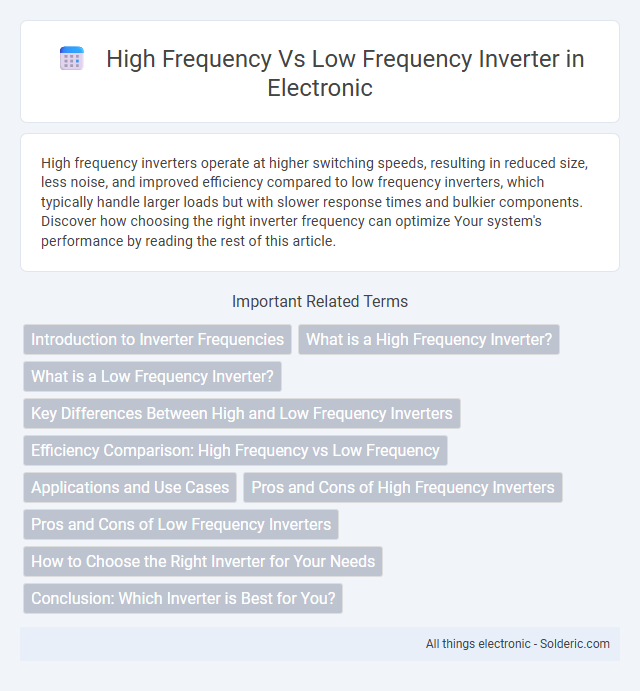High frequency inverters operate at higher switching speeds, resulting in reduced size, less noise, and improved efficiency compared to low frequency inverters, which typically handle larger loads but with slower response times and bulkier components. Discover how choosing the right inverter frequency can optimize Your system's performance by reading the rest of this article.
Comparison Table
| Feature | High Frequency Inverter | Low Frequency Inverter |
|---|---|---|
| Frequency Range | 20 kHz and above | 50 Hz to 60 Hz |
| Size and Weight | Compact, lightweight | Larger, heavier |
| Efficiency | High efficiency (90%-98%) | Moderate efficiency (75%-85%) |
| Output Waveform | Pure sine wave or modified sine wave | Pure sine wave |
| Switching Devices | IGBT, MOSFET | Thyristor, SCR |
| Applications | Portable devices, solar inverters, UPS | Industrial drives, heavy machinery |
| Cost | Higher initial cost | Lower initial cost |
| Heat Dissipation | Better thermal management | Higher heat generation |
Introduction to Inverter Frequencies
Inverter frequencies determine the switching speed at which electrical power is converted from DC to AC, impacting performance and efficiency. High frequency inverters operate typically above 20 kHz, offering reduced size, lighter weight, and improved output waveform quality, ideal for sensitive electronics. Low frequency inverters switch at lower rates, generally below 20 kHz, providing robustness and efficiency for heavy-duty applications, shaping how your devices manage power conversion.
What is a High Frequency Inverter?
A high frequency inverter converts DC power into AC power at frequencies significantly higher than the standard 50 or 60 Hz, typically ranging from tens of kilohertz to several hundred kilohertz. This high switching frequency reduces the size and weight of transformers and inductors, resulting in more compact and efficient power conversion systems. High frequency inverters are widely used in applications like renewable energy systems, electric vehicles, and high-efficiency power supplies due to their fast response and improved performance.
What is a Low Frequency Inverter?
A Low Frequency Inverter converts DC power into AC power by first converting DC to low-frequency AC, then using a heavy transformer to step up or step down the voltage. These inverters typically operate at 50 or 60 Hz, making them robust and suitable for high-power applications like solar energy systems or heavy machinery. Your choice of a low frequency inverter offers enhanced durability and better surge handling compared to high frequency inverters.
Key Differences Between High and Low Frequency Inverters
High frequency inverters operate at switching frequencies above 20 kHz, resulting in smaller, lighter transformers and faster response times, while low frequency inverters typically switch below 1 kHz, featuring larger transformers and longer response times. High frequency inverters provide higher efficiency and better power quality, making them ideal for applications requiring compact size and precise control, whereas low frequency inverters are preferred for handling high power loads with simpler design and robustness. Understanding these key differences helps you select the appropriate inverter for your specific power conversion needs.
Efficiency Comparison: High Frequency vs Low Frequency
High frequency inverters typically offer higher efficiency rates, often exceeding 90%, due to reduced core losses and lighter transformers compared to low frequency inverters. Low frequency inverters, operating at 50 or 60 Hz, tend to have heavier iron and copper losses, resulting in efficiency levels often below 85%. The efficiency advantage of high frequency inverters makes them preferable for applications demanding compact size and reduced energy consumption.
Applications and Use Cases
High frequency inverters are commonly used in applications requiring compact size and high efficiency, such as renewable energy systems, electric vehicles, and telecommunications equipment, where rapid switching and reduced electromagnetic interference are critical. Low frequency inverters are ideal for heavy-duty industrial machinery, large motor drives, and power transmission systems, offering robustness and the ability to handle high power loads with lower switching losses. Understanding the specific demands of your application helps in selecting the appropriate inverter type to optimize performance and reliability.
Pros and Cons of High Frequency Inverters
High frequency inverters offer compact size, higher efficiency, and reduced electromagnetic interference, making them ideal for applications requiring precise control and lightweight design. You benefit from faster switching speeds and better waveform quality, which enhance performance in sensitive electronics and renewable energy systems. However, they tend to be more expensive, generate higher switching losses at elevated power levels, and may require advanced cooling solutions compared to low frequency inverters.
Pros and Cons of Low Frequency Inverters
Low frequency inverters are known for their robust design, making them highly durable and capable of handling higher surge currents, which is ideal for heavy-duty industrial applications. However, they tend to be larger, heavier, and less energy efficient compared to high frequency inverters, leading to increased installation space requirements and potential operational costs. Your choice of inverter should consider these factors, as low frequency models offer excellent reliability but may not be suitable for compact or energy-sensitive environments.
How to Choose the Right Inverter for Your Needs
Choosing the right inverter depends on your specific power requirements and application. High frequency inverters offer compact size, fast switching, and high efficiency, ideal for sensitive electronics and smaller loads. Low frequency inverters provide robust performance, better handling of large inductive loads, and superior durability for heavy-duty applications, making them suitable for industrial or large-scale solar systems.
Conclusion: Which Inverter is Best for You?
High frequency inverters offer compact size, higher efficiency, and faster response times, making them ideal for applications requiring precision and space savings. Low frequency inverters excel in handling high power loads and provide robust performance for heavy-duty industrial equipment. Your choice depends on whether you prioritize efficiency and size or power capacity and durability in your specific application.
High Frequency vs Low Frequency Inverter Infographic

 solderic.com
solderic.com